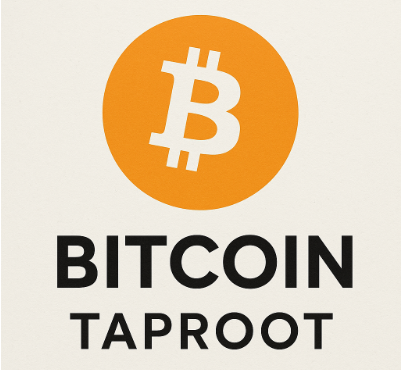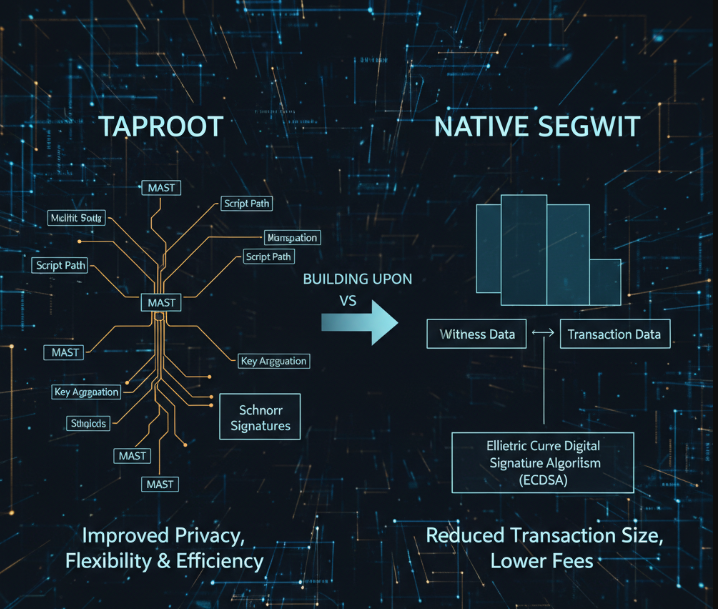Bitcoin Taproot vs. Native SegWit highlights two outstanding upgrades in the development of the Bitcoin network. Native SegWit solved transaction malleability, reduced fees, improved scalability, while Taproot added advanced network features like enhanced privacy, efficient signature aggregation, and smart contract capabilities.
These two upgrades showcase the progress that Bitcoin continues to make, balancing cost-effectiveness, privacy, and innovation to accommodate the users and developers growing needs in the digital economy.
What Is Bitcoin Taproot?
Bitcoin Taproot represents an important step forward regarding the efficiency, privacy, and flexibility of smart contracts on the Bitcoin network. Introduced in November 2021, Taproot permits intricate transactions to mimic simple transactions on the blockchain, concealing the user better.

It also minimizes the size of simple transactions, which lowers costs and improves network efficiency.
Combining Taproot with the Schnorr signature scheme allows for more complex Bitcoin smart contracts to be handled while still maintaining quick, cheap, and safe transactions. This upgrade significantly improves the everyday use of Bitcoin, focusing on versatility and scalability.
What is Native SegWit?
Native SegWit addresses, or Bech32 addresses, improve the Bitcoin protocol. Unlike traditional Bitcoin wallets, Native Segwit addresses begin with “bc1” which allows transactions to take up less block space, making transactions quicker and cheaper.

Segwit completely resolves transactional malleability making Bitcoin more secure and usable with more advanced systems like the Lightning Network.
Native SegWit focuses on maximizing Bitcoin’s efficiency in modern transactional demands, making sending and receiving BTC less complex and more economical.
Comparison: Bitcoin Taproot vs Native Segwit
| Feature | Native SegWit | Taproot |
|---|---|---|
| Scalability | Increased transaction throughput | Further efficiency improvements |
| Privacy | Basic privacy improvements | Enhanced privacy with complex transactions |
| Transaction Malleability | Resolved | N/A |
| Smart Contracts | Limited | Enhanced flexibility |
| Adoption Rate (2025) | 80%+ | Growing rapidly since 2021 |
The Benefits of Native Segwit
Smaller Transactions: Moving signature info outside the transactions means that the transactions will be smaller. More transactions can be completed in the same block which means greater overall processing of transactions.
No More Transactions Being Altered: Segwit prevents the altering of transactions which contributes to the reliability of the transaction processes.
More Use: Since 2025, it is estimated that more than 80% of bitcoins are processed using the Segwit method which is a clear sign of growing acceptance.
The Benefits of Taproot
Improved Confidentiality: Taproot conceals the complicated transactions under simpler ones which enhances the user’s confidentiality.
More Effective: Taproot is able to be more effective in processing transactions due to the Schnorr signatures.
Flexible Smart Contracts: It will be the most revolutionary thing if smart contracts are more flexible and scalable to enhance the variety of uses.
How It Works Native SegWit?
Currently, Bitcoin no longer just counts blocks in bytes. It is also measuring it in “weights.” Native SegWit uses this advantage because it assigns a lower weight to the witness data. With this, transactions using Native SegWit are relatively cheaper and smaller since the byte size will not dramatically change.
For Native SegWit, it will still be cheaper and smaller, since the transactions will still be using the 40-50% block size when compared to the legacy. This also means lower fees and quicker confirmation when the network is busy.
Why It Matters Native SegWit
For Users, Native SegWit is a big deal because:
- Lower fees – 20% up to 40% in savings compared to older formats
- Faster confirmation – No congestion as more transactions are allowed in a block.
- Lesser error – the new address format with check-sums prevents copy-paste errors.
- Unlock Lightning – With fixed transaction malleability, Native SegWit can connect to the Lightning Network using fast and off-chain solutions.
Native SegWit vs Taproot: The Key Differences
There are several similarities between Native SegWit and Taproot because both are designed to solve Bitcoin network scalability issues. These are the differences.
Efficiency
Native SegWit doesn’t enable signature aggregation but does decrease the size transactions. In contrast, Taproot improves the efficiency of transactions by aggregation and the batching of multiple signatures, thus reducing the costs and overall size of transactions.
Cost
Because Native SegWit transactions utilize less data, they are cheaper. In contrast, Taproot transactions utilize more data, resulting in higher costs.
Privacy
Native SegWit did not have any added privacy capabilities. Taproot improves privacy capabilities on the network by making multi-signature and single-signature transactions look the same.
Smart contract functionality
Native SegWit is devoid of smart contract capabilities. In contrast, Taproot incorporates less resource-intensive complex smart contracts.
Why Taproot Matters?
Taproot enhances Bitcoin in two primary ways:
Improved Privacy: Multi-signature transactions, smart contracts, and advanced state tree contracts all appear as simple transactions now, which protects user privacy and fungibility even more.
Advanced Functionality: Taproot enables more sophisticated Bitcoin applications, including atomic swaps, payment channels, and complex multi-party agreements. All of these features need less data, incur lower fees, and provide more privacy.
Advanced functionality benefits businesses a lot. For example, companies that need to run complex payrolls or provide escrow services can now automate these processes without exposing every transaction’s business logic to the public.
For users, this translates to a more private Bitcoin which also scores advanced features, all without compromising on security or decentralization.
Future Outlook: The Role of SegWit and Taproot in Bitcoin’s Evolution
SegWit and Taproot aim to improve scalability and efficiency and add greater privacy to Bitcoin. SegWit was the start. It reduced transaction sizes, solved malleability, and sped up the adoption of the Lightning Network.
Taproot enhances transaction efficiency and privacy and smart contract functionalities to make Bitcoin adaptable. These upgrades improve scalability, security, and usability, ensuring Bitcoin continues to adapt to user and tech changes.
Pros & Cons Bitcoin Taproot vs Native SegWit
| Feature | Native SegWit | Taproot |
|---|---|---|
| Pros | Reduces transaction size, lowering fees, Resolves transaction malleability• Widely adopted (80%+) | Improves transaction efficiency with signature aggregation, Enhances privacy, Supports complex smart contracts |
| Cons | Limited smart contract support, Minimal privacy improvements | Transactions can be slightly larger and costlier, Adoption still growing since 2021 |
Conclusion
As a Bitcoin network user, I value both Bitcoin network enhancements. Bitcoin network enhancements accommodate efficiency, and scalability, and lower fees. I adopted Bitcoin SegWit because it solves the issues of transaction malleability, and size and lowers fees, making transactions faster and cheaper.
I also appreciate the advancements made by Taproot, including superior privacy preservation, more effective limit signature consolidations, and complex smart contracts. Together, these enhancements are pivotal in strengthening the Bitcoin network for a more scalable, secure, and flexible network to meet users’ and Developers’ changing requirements.
FAQ
What is the main difference between Taproot and Native SegWit?
Native SegWit focuses on reducing transaction size, lowering fees, and fixing malleability, while Taproot enhances privacy, enables signature aggregation, and supports complex smart contracts.
Which is cheaper for transactions, Taproot or Native SegWit?
Native SegWit transactions are generally cheaper due to smaller data sizes, whereas Taproot transactions can be slightly more expensive because of additional features.
Do both upgrades improve privacy?
Native SegWit provides basic privacy improvements, but Taproot significantly enhances privacy by making single and multi-signature transactions appear similar.
Can I use smart contracts with Native SegWit or Taproot?
Native SegWit has limited smart contract support, while Taproot allows more complex smart contracts with lower resource requirements.
Which upgrade has higher adoption?
As of 2025, Native SegWit has over 80% adoption, while Taproot adoption is growing rapidly since its introduction in 2021.










